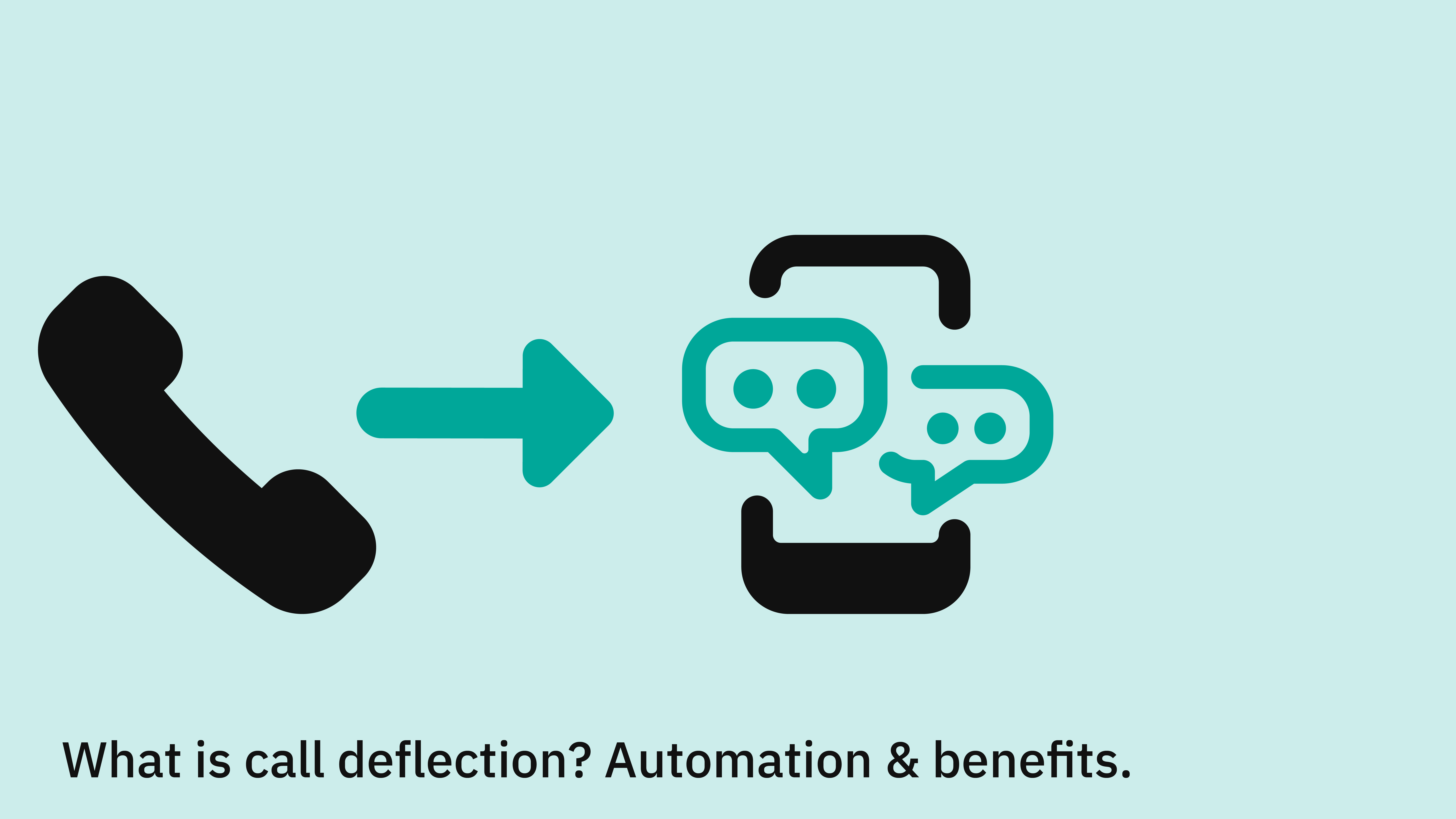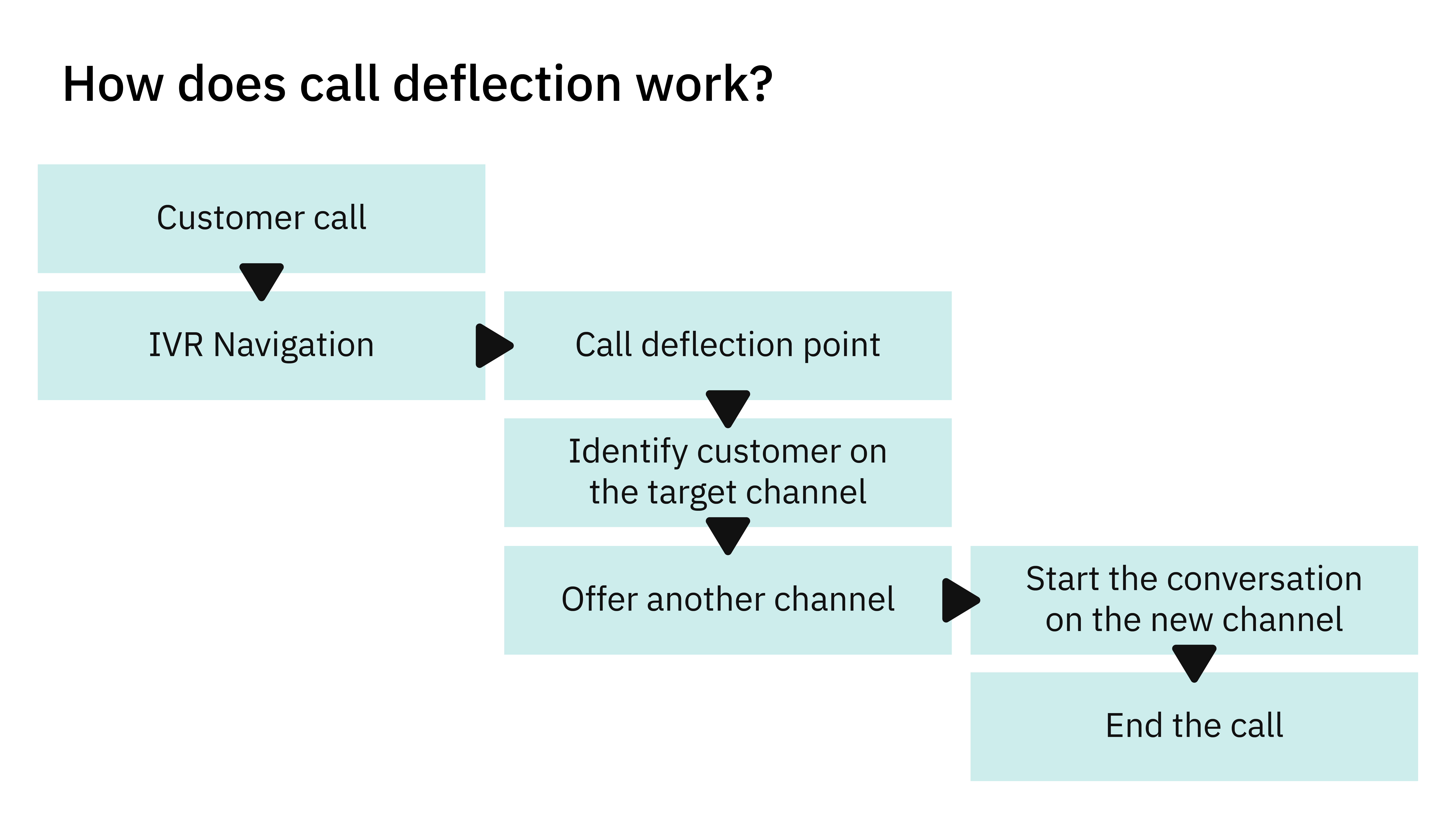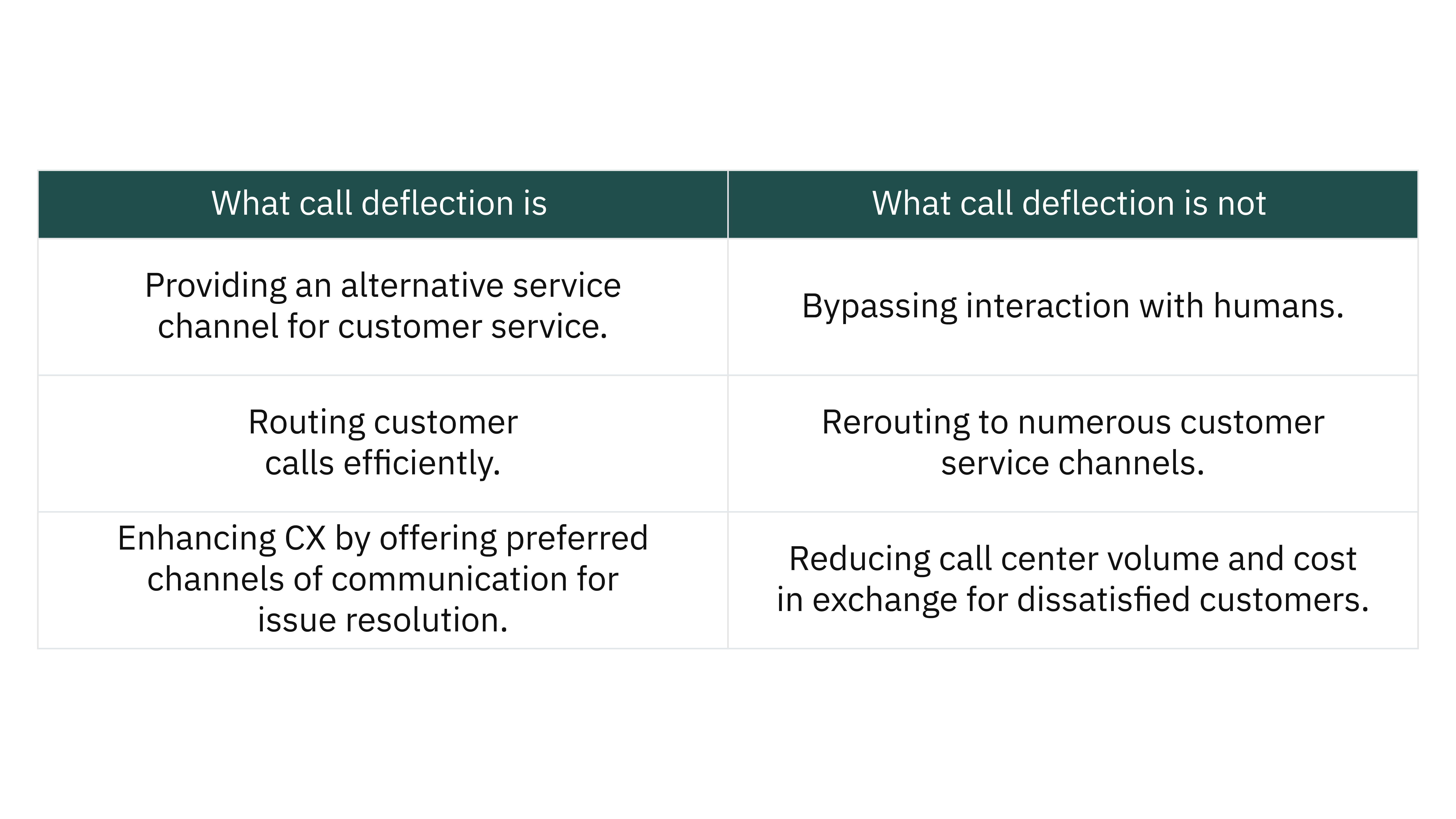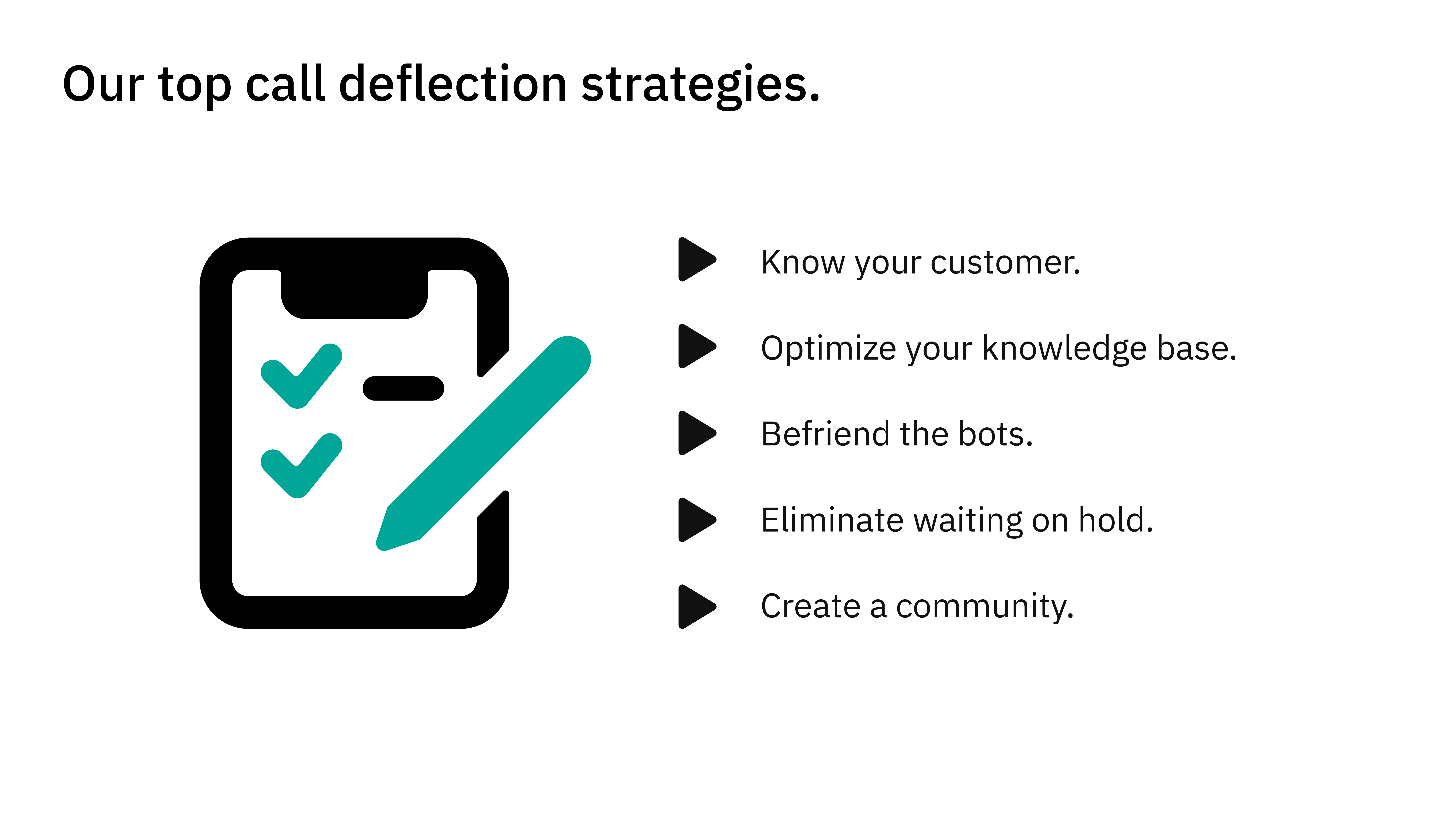What is call deflection? Automation & benefits.

It’s a busy day in your contact center, and the phones are ringing left and right. You’ve just released a new product or service, or maybe it's the holiday season and suddenly you’re thinking back to your peak management plan and how well you’ve implemented it. Your agents are highly trained and they’re doing the best they can to give your customers the best possible experience with your brand, but it’s proving tough with the high volumes coming in and you’re not sure if you’ll be able to keep a high satisfaction rate without incurring massive costs.
If this sounds a little too familiar to you, then it’s probably time you consider call deflection for your operations. Read on and find out what it is, how it can boost your business, and what secret benefits automation and digital services have to offer.
What is call deflection?
In its simplest form, call deflection is the process of redirecting a caller to the most appropriate channel, in order to help them quickly and efficiently get the solution they need. This could mean redirection amongst your agents and teams, using other digital channels, or implementing next-generation technology to aid in self-service.
The contact center software assesses incoming metrics such as duration, type, customer language preference, etc. and then routes it to the most appropriate agent or channel. Once contact is made, the agent, software, or channel can handle the request in a timely and efficient manner while providing quality service.

It helps to improve service by ensuring that each customer is connected with the most qualified agent or through the most effective channel for their needs. Additionally, it can help to automate your contact center and improve efficiency. In fact, a survey by McKinsey and Company found that brands who transition to digital CX can reduce costs by 30% while increasing satisfaction by 19%.
Amongst your teams and agents.
When call deflection is used, routing algorithms are implemented to help route calls in an efficient and cost-effective manner. For example, it can help reduce wait times by ensuring that the most appropriate agent is reached, or the call can be diverted to a team which is experiencing lower volumes currently and can support in a pinch. This technique is also used to match language skills with callers and increase customer satisfaction by connecting them with an agent who speaks their native language.
Digital channels.
This kind of automation can come in various forms, but one of the most common solutions, if you have an omnichannel-enabled support system, is to use various channels in the digital space. By spreading out the load evenly across different channels, your agents can still dedicate time to complex queries while leaving customers happy.
For example, a customer might contact your support team to ask about changing an address for a bill. During a surge, they could be waiting a very long time to speak to an agent on the phone. With call deflection, you can suggest that they continue the conversation uninterrupted but on a channel like WhatsApp for Business or Messenger. You might use IVR to get more information about their issue before they are redirected, so that the next person they speak to is able to help them quicker.
Self-service and bots.
When a customer calls with a simple question, you can use technology to inform them that the solution to their query is available on your company FAQ page. You might even redirect them to a channel where you have conversational AI technology that is equipped to handle their query. This combination of self-service options and bot technology is something we’ll come back to later on, but it can be highly effective in quickly managing high volumes.
In fact, a study by Harvard Business Review shows that 81% of customers try to find resolution on their own before reaching out to support teams.
Where can you use it?
With call deflection, it’s important to remember that there are three communication points. These are known as the originating gateway (the point where the call is made), the deflecting gateway (the endpoint, or the moment at which you deflect), and the deflected-to gateway (the final endpoint for the customer, or where they are deflected to).
With this in mind, this technology can be used at every stage of the customer journey. It can be offered prior to first contact through information materials, while the caller is waiting to be connected, or during the conversation. A business may even have several potential points of deflection, depending on how intense its peaks are or what customer habits are like. This is why it’s so crucial for companies to analyze their users behavior, and using that data, define where it can best be implemented.
Call deflection can be used on phone, email, website chatbot, SMS/text messaging and social media. By utilizing multiple channels of communication, your CX can be improved across the board, whether it’s through WhatsApp, FB Messenger, Apple Business Chat, SMS, or even a bot widget on your website.
How is call deflection different from call forwarding?
The former is the process of routing a call to the most appropriate agent, whereas forwarding is simply forwarding from one number to another. Call deflection takes into account data such as language preferences or previous history in order to route calls efficiently, whereas call forwarding does not consider any customer information when making connections.

What are the benefits?
Aside from lowering costs, increasing satisfaction, and improving agent performance, there are many other benefits to implementing this solution in your contact center. When integrated as part of a solid peak management plan, it can be a gamechanger for your customer support services.
Improved efficiency.
Instead of manually redirecting calls or inputting the same information over and over again, a call deflection software can keep all of your data in one place to make it easier for various agents to jump in and solve a query. It also means you don’t overload one individual or team with more work than they can handle, while saving on potential costs associated with hiring more staff, decreasing AHT, and improving your FCR.
Let me choose!
Customers are always looking for different ways to get in touch with a brand, but fundamentally, they just want to feel heard and have their problem solved. By giving them a choice of channel to communicate on, they may feel more comfortable communicating with you - some people prefer to use chat or self-service options rather than speak to an agent, and it could also in certain cases be a preferred channel due to technical, physical, or societal limitations.
Increased security and privacy.
When it comes to things like sharing contact details, financial information, or other sensitive data on the phone, many customers may feel uncomfortable saying this out loud or giving this information to a voice on the phone. A different channel may give them more privacy, and encryption software can ensure tighter cyber security for these kinds of transactions.
Cost savings.
Without the need to hire additional staff to handle high volumes, or purchasing expensive and complex software that cannot be fully integrated into your systems, you may find yourself actually saving on costs by spending a little less on an effective call deflection solution. In the long run, it will also help you maintain a high customer satisfaction and loyalty level, which will ultimately bring your business greater benefits.
More digital = more happy.
When more than 73% of customers think that long waiting times are their main frustration when calling customer service, you know you have to do whatever you can to limit that factor. Using digital solutions such as call deflection can help you preempt this irritation, increase CSAT and NPS, and give your consumers a speedy resolution to their issues. They may love your brand, but that doesn’t mean they should spend all day on the phone with you!
Multitasking agents.
Your agents are your most precious resource, and their extensive skills and knowledge should be utilized in the most efficient way possible. With call deflection, they can dedicate time to more complex cases, training, and helping customers with very nuanced cases. This will likely keep them happier and give them more motivation to bring a lot of energy to each interaction.
Our top strategies.
As with many solutions, the best way to go is to find an experienced customer service partner who can guide you through the process, analyze your customers’ data, and advise you on where and how to implement a new technology. Thankfully, we’re experts here at Transcom, and our CX Advisory team would be more than happy to have a conversation with you about your brand’s needs.
In the meantime, we wanted to share some of our top tips and considerations for creating the best call deflection strategy, and what you should look out for.

How do we measure success?
To measure the effectiveness of call deflection, contact centers should track metrics such as resolution rate, average duration and customer satisfaction. These metrics can be used to determine if your strategy is meeting objectives and delivering a positive return on investment. Other ideas for keeping an eye on results include:
- Configure intelligent IVR to serve callers and monitor how often it is used.
- Keep an eye on volumes and ASA times.
- Use workforce management tools to check in on your teams.
- Build self-serve options into your contact page and track traffic.
- Use customer surveys to gauge their sentiment.
The call deflection rate is the percentage of incoming callers that are routed to deflecting channels such as SMS/text messaging, website chatbot or self-service portals. A rate of 70% or higher indicates that contact centers are efficiently routing callers to solutions without requiring agent assistance.
By tracking and analyzing these metrics, you can ensure that your strategies are working for your customers.